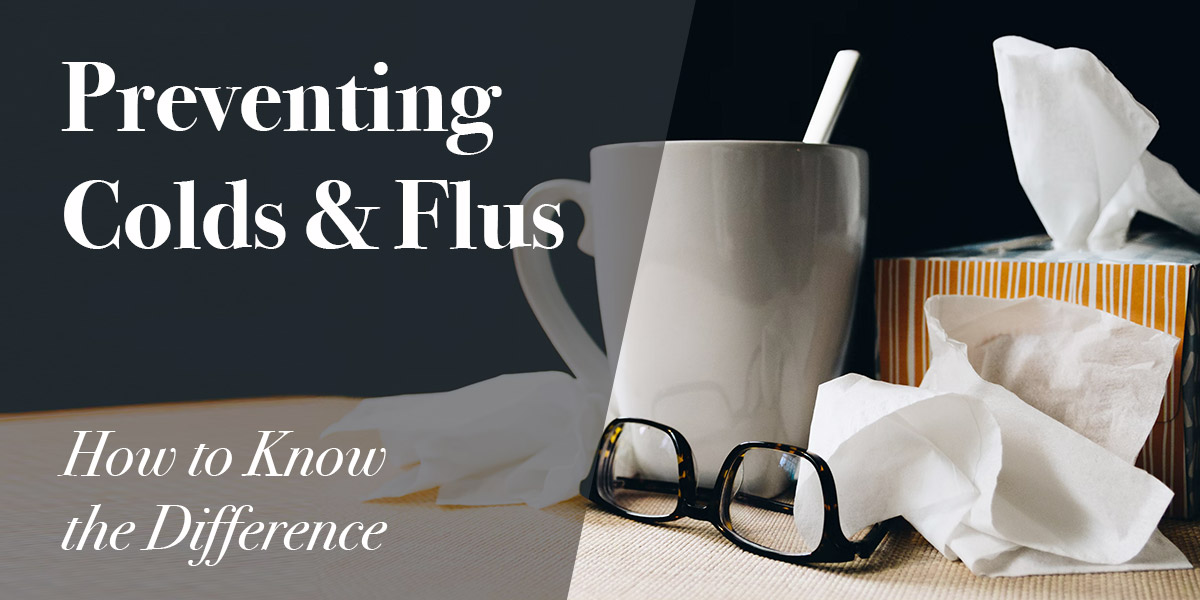Did You Know?
- Common colds are the leading cause for children missing school and adults missing work.
- During an average flu season 20% of the population will get the flu.
- The flu can be spread to others from 6 feet away.
- The best way to prevent the flu is to get vaccinated annually.
- Colds are usually milder than the flu.
- People with colds are more likely to have a runny or stuffy nose.
- Symptoms usually include sneezing, nasal congestion, sore throat, cough, watery eyes, headache and fatigue.
- Symptoms usually last for 7 to 10 days and may last up to 2 weeks.
- Colds usually do not result in serious health problems such as pneumonia, infections, or hospitalizations.
Is It a Cold or the Flu?
While a common cold can be caused by more than 200 viruses (rhinovirus is the most common); the seasonal flu is caused by the influenza A or B virus. This is why there is a vaccine available for the flu and not for colds.
Cold Relief
There is no cure for the common cold. To help you feel better treat your symptoms while your body fights off the virus. Since the common cold is caused by a virus, antibiotics will not help it get better. A runny nose or cold almost always gets better on its own. To feel better when you have a cold, consider the following:
- Get plenty of rest
- Drink lots of fluids such as water and clear liquids. This will help loosen mucus and help prevent dehydration.
- Know that over the counter (OTC) medications may help with symptoms but do not make your cold go away faster as the virus needs to run its course. You should take all medications as directed. If symptoms do not go away call your health care provider for medical advice. Be sure to talk with your child’s health care provider before using a non-prescription OTC medication for your child.
How Will I Know if I Have the Flu?
There are tests available to diagnose the flu. The most common test is the “rapid influenza diagnostic test.” This test can provide results in 30 minutes or less. The ability of these tests to detect the flu can vary greatly, and may be better at detecting the flu in children than in adults. Most people with flu symptoms do not require testing because the test results usually do not change how you are treated. Your health care provider may diagnose you with the flu based on your symptoms, and their clinical judgment, or they may choose to use an influenza diagnostic test.
It is possible to have the flu, as well as other respiratory illnesses, and COVID-19 at the same time. Some of the symptoms of flu and COVID-19 are similar, which may make it hard to tell the difference between the two based on symptoms alone. Diagnostic testing may help your health care provider determine if you have the flu or COVID-19.
- The flu is a contagious respiratory illness caused by the influenza virus.
- The flu tends to occur in the colder months of the year.
- Symptoms of the flu are worse than the common cold and may include fever, chills, sore throat, muscle or body aches, headaches, fatigue, vomiting and diarrhea (more common in children).
- Fever, body aches, extreme tiredness, and dry cough are more common with the flu and more intense than when associated with a cold.
- The best way to prevent the flu is to get vaccinated annually.
When Treating the Flu:
- Get plenty of rest.
- Drink a lot of fluids like water, broth, sport drinks or electrolyte beverages to prevent becoming dehydrated.
- Use a humidifier to help make breathing easier.
- The use of over the counter medications may relieve some flu symptoms, but will not make you less contagious.
- Know that antiviral medications can reduce the duration of your illness and the complications associated with the flu. These should be started as early as possible, preferably within 48 hours after the onset of the illness.
- Follow up with your health care provider if you experience side effects or worsening symptoms that may require emergency care.
Preventive Measures May Reduce Your Risk of Developing the Flu
- Protect yourself and others by staying away from people who are sick and by staying home from work and social activities if you are ill.
- Wash your hands. Handwashing is the most protective way to keep germs away. When washing your hands be sure to lather well with soap including the backs of your hands, under your nails and between your fingers. Scrub for at least 20 seconds, rinse well and dry.
- Live a healthier lifestyle by eating healthier, exercising, getting adequate sleep and managing your stress levels.
- Get the annual flu vaccine. The flu vaccine may reduce flu illnesses, doctor visits, and missed work and school due to the flu, as well as prevent flu-related hospitalizations.

